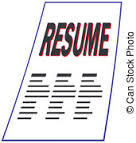Although resumes are every candidate’s gateway to an exciting new career, employers must be aware they could be letting in a Trojan horse.
Sadly, evaluating a resume not only includes determining which candidate is the most suitable for the job, but also weeding out those applications that are fraudulent.
The surge in online recruitment has opened up another window for those willing to lie their way into job.
The numerous ways in which resumes can be evaluated fall into two basic categories – appearance and content.
Regarding appearance, neatness and a good layout is generally regarded as important, not just because neatness is itself a desirable attribute in any employee but also because it shows an innate professionalism and attention to detail.
Some employers even take into account whether the heading styles and sizes are consistent and the bullet points line up.
Other obvious appearance faults are spelling mistakes – again because they show a lack of professionalism.
Regarding resume content, it is important to eliminate the “one-size-fits-all” resumes, fired off en masse in the hope that one may hit home. Not only may the candidate who sends these not be a good match, they may also just be after a stop-gap position to pay the rent until something better comes along.
Probably one of the most important aspects of the actual content of the resume is the match between the career objectives of the applicant and what the organization can provide. For example, someone seeking a highly structured career path with many benefits such as private health insurance would probably not be well-suited to a small start-up company.
It is also important that the candidate’s past responsibilities match the vacancy, or at least show an aptitude for quickly assuming the required skills and responsibilities.
When assessing accomplishments, an employer should be looking for solid achievements (especially those relating to generating profit for previous employers).
The employer should be wary of phrases that are meant to imply much more than they actually say.
These include statements that the candidate is “familiar with” a certain computer program as against stating a specific level of proficiency, or was “involved with” a certain corporate success rather than having initiated or was responsible for its profitability.
Other warning signs are gaps in the employment history; inability to specify that the candidate has permission to work in the country (in the US this can involve spotting fraudulent SS numbers); gaps in the work history and inflated salary histories.
Every employer has their own personal list of resume dislikes which, although they may not be an accurate reflection of the candidate’s ability to do the job, do indicate a lack of professionalism and a distinct lack of a sense of what is appropriate.
They include photocopies of photocopied resumes, poor quality paper, fancy graphics, mentions of old jobs that don’t mean anything and hand-written corrections.
Much more serious than personal dislikes is resume fraud. A survey carried out by Accountemps in 1998 found that 30 percent of candidates lied or left out important information on their resumes.
The surge in online resumes is beneficial because it shows that the candidate is computer literate and has access to technology. In the US, it is becoming increasingly unlikely for some companies to hire candidates who submit their resumes by fax or mail.
However, they make resume fraud much easier. Some applicants enter the key words they know will get them through a computerized screening process, which means that recruiters and hiring managers sometimes end up hiring a person with no knowledge of what they claim.
Even more worrying is the increasing prevalence of paid referrals, whereby companies will offer to substantiate false work experience for a fee, even though a person has never worked for them
The cost of hiring an employee with a fraudulent resume can be enormous, and not just because the whole hiring process has start again after they have been discovered.
Even if it is decided to retain the employee, the cost can include that of covert on-the-job-training, where it is cheaper to train the candidate than go through the hiring cycle again.
The whole process of hiring staff can therefore be a tricky one. But with a clear expectation of what the position requires from its successful candidate, and an awareness of what to look for, an informed evaluation of the resume can make it an easier.
Copyright 2001, RAN ONE Inc. All rights reserved. Reprinted with permission from www.ranone.com.

 Chris’ combination of academic credentials, career experience and temperament ideally suit his calling as a business development advisor. Clients say he has a mind for business and a heart for service.
Chris’ combination of academic credentials, career experience and temperament ideally suit his calling as a business development advisor. Clients say he has a mind for business and a heart for service.